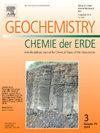Petrology and P-T evolution of high-grade garnet metabasites from the Tin Begane area (Laouni terrane, South Algeria)
IF 2.9
3区 地球科学
Q2 GEOCHEMISTRY & GEOPHYSICS
引用次数: 0
Abstract
The south of the Tin Begane region (Laouni terrane, Central Hoggar, southern Algeria) has been subjected to high grade metamorphism and shows well-preserved relicts of garnet-bearing metabasites boudinaged within metapelites and migmatites. These rocks have preserved a number of spectacular mineral assemblages and reaction microstructures. Two successive metamorphic stages have been recognised, on the basis of metamorphic microstructures and mineral compositions: (i) the main primary paragenesis consists of garnet porphyroblasts, amphibole, clinopyroxene, titanite and quartz; (ii) the retrograde stage is evidenced by clinopyroxene-amphibole-plagioclase symplectites, which developed mainly at the expense of garnet, as well as peculiar clinopyroxene-ilmenite symplectites after titanite. Garnet porphyroblasts are almandine-grossular (Alm46–58 Prp7–14 Grs28–42 Sps1–5) and show a smooth zoning pattern from the core to the outer rim. The clinopyroxene is diopside but shows slight chemical variations depending on its microstructural position in the rock (inclusion in garnet: XFe = 0.39; Altotal = 0.06 apfu; Ca = 0.90 apfu; ameboid crystals in the matrix: XFe = 0.42–0.47; Altotal = 0.15–0.16 apfu; Ca = 0.90–0.93 apfu; clinopyroxene in symplectite: XFe = 0.37–0.52; Altotal = 0.06–0.11 apfu; Ca = 0.91–0.95 apfu). The amphibole is (ferro-)tchermackite to (ferro/magnesio)-hornblende, with some grains exhibiting a smooth chemical zoning profile from core to rim. Plagioclase, either from the main paragenesis or from the Cpx + Pl symplectites, is anorthite (XAn = 0.92–0.97). To reconstruct the pressure-temperature evolution of a selected sample, two P-T pseudosections were calculated in the NCKFMASHTO system. The first pseudosection was modelled using the bulk-rock composition of the sample, whereas the second was calculated for the overall composition of the late symplectites, estimated by balancing the reaction that produced them. The results indicate that the studied metabasites have experienced a clockwise P-T path, with a decompression from peak conditions estimated at 13–15 kbar and 750 ± 50 °C down to 7–4.5 kbar and 810 ± 50 °C. The clockwise P-T path can be interpreted in terms of crustal thickening followed by exhumation, most likely during the Pan-African orogenesis.
阿尔及利亚南部Laouni地块Tin Begane地区高品位石榴石变质岩的岩石学及P-T演化
Tin Begane地区南部(阿尔及利亚南部Hoggar中部Laouni地体)经历了高变质作用,在变质岩和混辉岩之间发现了保存完好的含石榴石变质岩遗迹。这些岩石保存了许多壮观的矿物组合和反应微观结构。根据变质微观结构和矿物组成,确定了两个连续的变质阶段:(1)主要的原生共生由石榴石卟啉母岩、角闪孔、斜辉石、钛矿和石英组成;(ii)逆行期主要发育斜辉石-角闪石-斜长石共长岩,主要以石榴石为代价发育,在钛矿之后还发育了特殊的斜辉石-钛铁矿共长岩。石榴石卟啉母细胞为almandinine -grossular (Alm46-58 Prp7-14 Grs28-42 Sps1-5),从核心到外缘呈光滑的分带模式。斜辉石为透辉石,但根据其在岩石中的显微结构位置(在石榴石中的包裹体:XFe = 0.39;Altotal = 0.06 apfu;Ca = 0.90 apfu;基体中阿米巴晶体:XFe = 0.42-0.47;Altotal = 0.15-0.16 apfu;Ca = 0.90-0.93 apfu;斜辉石:XFe = 0.37-0.52;Altotal = 0.06-0.11 apfu;Ca = 0.91-0.95 apfu)。角闪孔为(铁-)镁铁-(铁/镁)角闪石-(铁/镁)角闪石,部分颗粒从岩心到边缘呈光滑的化学分带剖面。斜长石为钙长石(XAn = 0.92-0.97),无论是来自主共生体还是来自Cpx + Pl合生体。为了重建选定样品的压力-温度演化,在NCKFMASHTO体系中计算了两个P-T伪截面。第一个伪剖面是使用样品的整体岩石组成来建模的,而第二个伪剖面是通过平衡产生它们的反应来计算晚期复合岩的整体组成。结果表明,所研究的变质岩经历了顺时针的P-T路径,减压从峰值条件估计为13-15 kbar和750±50°C下降到7-4.5 kbar和810±50°C。顺时针的P-T路径可以解释为地壳增厚之后的挖掘,最有可能是在泛非造山运动期间。
本文章由计算机程序翻译,如有差异,请以英文原文为准。
求助全文
约1分钟内获得全文
求助全文
来源期刊

Chemie Der Erde-Geochemistry
地学-地球化学与地球物理
CiteScore
7.10
自引率
0.00%
发文量
40
审稿时长
3.0 months
期刊介绍:
GEOCHEMISTRY was founded as Chemie der Erde 1914 in Jena, and, hence, is one of the oldest journals for geochemistry-related topics.
GEOCHEMISTRY (formerly Chemie der Erde / Geochemistry) publishes original research papers, short communications, reviews of selected topics, and high-class invited review articles addressed at broad geosciences audience. Publications dealing with interdisciplinary questions are particularly welcome. Young scientists are especially encouraged to submit their work. Contributions will be published exclusively in English. The journal, through very personalized consultation and its worldwide distribution, offers entry into the world of international scientific communication, and promotes interdisciplinary discussion on chemical problems in a broad spectrum of geosciences.
The following topics are covered by the expertise of the members of the editorial board (see below):
-cosmochemistry, meteoritics-
igneous, metamorphic, and sedimentary petrology-
volcanology-
low & high temperature geochemistry-
experimental - theoretical - field related studies-
mineralogy - crystallography-
environmental geosciences-
archaeometry
 求助内容:
求助内容: 应助结果提醒方式:
应助结果提醒方式:


